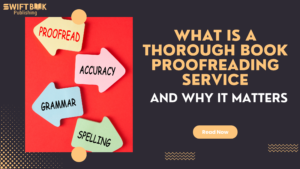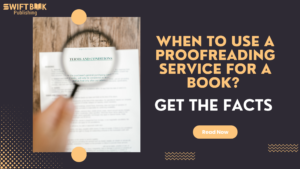Effectively marketing a book is an essential step in the journey of any author aiming to reach a wider audience and achieve commercial success. The book market is highly competitive, with countless titles vying for readers’ attention. Authors and publishers must craft a strategic plan to market a book that not only resonates with their target audience but also highlights the unique selling points of their book. It’s important to leverage a multifaceted approach that includes both online and offline tactics, ensuring that the book becomes visible in a saturated marketplace.
Understanding the market is the first order of business; this involves identifying the right demographic, analysing competitor strategies, and recognising trends that may affect sales. Engaging with readers through various platforms—be it social media, author websites, or book signings—can cultivate a dedicated readership. Techniques such as search engine optimization and advertising on Swift can be particularly beneficial in increasing online visibility. Employing services such as print on demand can streamline distribution without significant upfront costs.
In addition to these methods, creating captivating book covers, crafting compelling descriptions, and garnering reviews are crucial elements that can influence a reader’s decision to purchase. Authors may also consider various promotional tactics like reader magnets, discounts, and partnerships to boost their book’s profile. It is a continuous effort, requiring authors to adapt as they glean more insights about their readers and the effectiveness of their marketing strategies.
Understanding Your Target Audience
Before a writer can effectively market their book, they must pinpoint who it is tailored to. This entails a deep understanding of the potential readership – from the individual who will resonate most with the content to the larger demographic slices that define the consumer base.
Identifying Your Ideal Reader
The journey to successful book marketing begins with painting a vivid portrait of the ideal reader. Authors should ask themselves questions that home in on the age, interests, and reading habits of the envisioned consumer – the person whose life could be transformed by the book. This involves an introspective look at the book’s themes and messages to establish a clear image of who would derive the most value from its pages.
Researching Reader Demographics
Understanding the reader demographics is essential for positioning a book effectively in the market. Key metrics include age, gender, occupation, education, and location. For instance, if a book delves into complex technological concepts, its primary readers might be professionals in the tech industry likely with a higher education level. Mining data from book sales statistics or platforms where potential readers cluster can unveil volumes about the audience’s composition.
Leveraging Reader Interests and Behaviours
Finally, to truly resonate with potential readers, an author must comprehend their interests and behaviours. For a novel geared towards young adults, tapping into current trends, language style, and thematic preferences can greatly influence its reception. Utilising insights from social media trends, popular topics within book clubs, and even the feedback from early readers are invaluable in aligning marketing efforts with what genuinely engages and excites the targeted readership.
Crafting a Strong Brand Image
The essence of crafting a strong brand image lies in visual appeal, professional presentation, and cohesive messaging which sets the tone for how potential readers perceive the book and its author.
Designing a Compelling Book Cover
The book cover design acts as the first point of contact and requires careful consideration. It should capture attention and convey the book’s core theme. A compelling cover should balance eye-catching imagery with legible typography, ensuring the title and author’s name are prominently displayed.
Creating a Professional Author Bio
A professional author bio offers a snapshot of the author’s background and credentials. It’s critical to maintain professionalism while showcasing personality and past work, enabling the author to establish credibility and connect with readers on a personal level.
Developing a Consistent Messaging Strategy
A consistent messaging strategy ensures that all promotional materials and communications resonate with the book’s key themes and the author’s brand. This strategy includes a uniform tone and style across all platforms, from the book’s back cover to social media posts, maintaining brand coherence and recognition.
Maximising Online Presence
In today’s digital age, an author’s visibility hinges on their online presence. Effective strategies include establishing a dedicated author website, actively participating in social media, and leveraging the power of email marketing.
Building an Author Website
An author must create a professional website that acts as a central hub for their work. The website should include a detailed biography, a catalogue of books, and upcoming events. It’s also wise to feature a blog to share insights and updates, keeping the website dynamic and fresh. Information should be easy to find, with a clean, navigable layout.
Engaging with Social Media
Social media presents a vast potential audience. Authors should identify platforms where their readers are most active and engage with them by sharing content related to their books and interests. This could include behind-the-scenes glimpses of the writing process, book excerpts, or industry commentary. Interaction is key; authors should respond to comments and messages to foster a community around their work.
Utilising Email Marketing
Finally, email marketing allows for direct communication with readers. Authors should encourage website visitors to subscribe to their newsletters. Segmented email campaigns can then provide tailored content, such as new release announcements, discounts on books, and exclusive peeks into the author’s writing life. Email analytics can offer insights into reader preferences and engagement levels.
By implementing these strategies with consistency and care, authors can significantly enhance their online presence and visibility to their target audience.
Leveraging Book Reviews and Endorsements
Securing book reviews and endorsements prior to launch can significantly boost a book’s visibility. These elements not only provide credibility but also serve as a powerful tool in the book marketing arsenal.
Seeking Early Reviews
When authors seek early reviews, they tap into a pre-launch strategy that can create buzz and anticipation. It’s crucial to approach credible reviewers who can provide trustworthy and constructive feedback. Authors should consider sending advance review copies (ARCs) to book bloggers, librarians, and industry professionals who can offer a diverse range of opinions and amplify the book’s presence across different platforms.
Connecting with Influencers
Establishing a connection with influencers in the literary world can be a game-changer for book promotion. These influencers often have a vast following and the ability to sway readers’ purchasing decisions. Authors would benefit from identifying and reaching out to such figures, ensuring their book aligns with the influencer’s genre or area of interest for the best chance of securing their endorsement.
Navigating Review Platforms
Authors should make the most of review platforms by understanding their guidelines and focusing on the most relevant ones. Strategies include creating a presence on sites like Goodreads and consistently engaging with readers. Moreover, registering the book with well-known platforms that specialise in book reviews can lead to higher visibility and more opportunities for reader engagement.
Exploring Publishing Options
When considering how to market a book, one must first navigate the landscape of publishing options available. This entails a thorough comparison of traditional and self-publishing, understanding the various channels through which a book can be distributed, and selecting a reputable publishing service that aligns with your book’s needs.
Traditional vs Self-Publishing
Traditional publishing involves securing a contract with a publishing house that will assume responsibility for the production, distribution, and sometimes marketing of the book. Authors receive royalties on the sale of their books but relinquish some creative control and rights to the publisher. On the other hand, self-publishing allows authors to retain full control and rights to their work, along with a higher share of the profits. However, it requires them to manage all aspects of the publishing process, from editing and design to distribution and promotion.
Understanding Distribution Channels
Distribution channels are the avenues through which a book is sold to the public. Traditional publishing typically uses established retail connections, allowing books to reach physical and online bookstores efficiently. In contrast, self-published authors may rely on online platforms such as Swift, or they can employ services that distribute to multiple retailers, offering potential budget-friendly ways to promote their book.
Selecting the Right Publishing Service
Choosing a publishing service is critical, whether one opts for self-publishing or seeks a more collaborative partnership. Services can range from basic publishing support to comprehensive packages that include editing, design, and marketing. Key considerations include the quality of services offered, cost, and the publisher’s track record in successfully launching similar titles. Authors must weigh these factors carefully to ensure their book reaches its intended audience effectively.
Networking and Community Building
Successful book marketing often hinges on an author’s ability to network and cultivate a supportive community. This not only creates opportunities for exposure but also fosters relationships that can be instrumental in promoting a book.
Joining Writing and Reading Groups
Writers and readers often congregate in specialised groups that provide a platform for discussion, feedback, and mutual support. Joining these communities can lead to valuable connections, potential readership growth, and rich insights into the literary market. Authors should actively participate and contribute to these groups to establish their presence.
Participating in Literary Events
Literary events such as book fairs, readings, and workshops offer direct opportunities to engage with passionate readers and industry professionals. Authors should not only attend but also seek speaking opportunities at these events to increase their visibility. Participation can lead to media exposure and a stronger professional network.
Collaborating with Other Authors
Strategic partnerships with fellow authors can be mutually beneficial. Authors can cross-promote each other’s work, which may lead to reaching a wider audience. Initiatives like co-authoring projects, hosting joint events, or forming collectives are excellent methods for amplifying book promotion efforts.
By implementing these specific strategies, authors can more effectively market their books through well-established networking channels and community engagement.
Implementing Effective Advertising Strategies
Successful book marketing hinges on well-executed advertising strategies, which involve choosing appropriate platforms, crafting compelling ad copy, and allocating a budget sensibly.
Choosing the Right Advertising Platforms
In selecting advertising platforms, authors must identify where their target audience congregates. For mass-market appeal, TikTok ads can reach millions, especially during summer when engagement peaks. Conversely, niche works may benefit from specialised forums or literary blogs where readers seek out specific genres.
Creating Impactful Ad Copy
The ad copy must be engaging and concise. It should highlight what sets the book apart. For example, emphasising a unique setting or a compelling protagonist can pique interest. Additionally, integrating testimonials or accolades within the copy can boost credibility. When appropriate, a call-to-action such as “Learn more” or “Get your copy now” should be clear and persuasive.
Setting an Advertising Budget
Authors must determine their advertising budget based on their overall marketing goals and the cost-effectiveness of selected platforms. A budget can be outlined using the following format:
| Platform | Daily Budget | Duration | Total Spend |
| TikTok | £20 | 30 days | £600 |
| Literary Blog | £50 | 14 days | £700 |
Initial campaigns should start small to test effectiveness before scaling up. Continuous monitoring and adjusting of the budget are crucial based on the performance metrics from each platform.
Organising Book Launches and Promotions
Organising effective book launches and promotions requires careful planning and execution. This section details the essentials of setting up a launch event, running promotional discounts, and leveraging cross-promotion strategies.
Planning a Book Launch Event
A book launch event is a powerful way to generate interest and buzz around a new release. Authors should select a fitting venue, whether it’s a local bookshop or a virtual platform if targeting a wider, global audience. Invitations should be sent out well in advance, and the author may consider partnering with other local businesses to add value to the event.
Running Promotional Discounts
Offering discounts for a limited time can incentivise potential readers to purchase a book. A discount strategy should be designed to capture the audience’s attention quickly, making use of call-to-action language such as “limited offer” or “exclusive discount.” One must monitor the results to understand the effectiveness of the pricing strategy and adjust accordingly.
Utilising Cross-Promotion Opportunities
Cross-promotion involves partnering with other authors or organisations to reach wider audiences. An author could collaborate on joint readings, interviews, or feature swaps in newsletters. It’s key to choose partners whose reader base aligns well with the book’s target demographic for mutual benefit.
Monitoring and Adapting Marketing Efforts
Effective marketing requires diligent observation and the willingness to make changes based on what the data show. This involves a continuous cycle of measuring, evaluating, and adjusting your efforts to maximise the impact of your book marketing campaigns.
Tracking Marketing Metrics
The first step in monitoring your book marketing efforts is to track key metrics. These can include website traffic, conversion rates, social media engagement, and email open and click-through rates. Tools such as Google Analytics can offer in-depth insights into how users interact with your marketing content. Keeping a close eye on these metrics allows authors to gauge the effectiveness of their strategies.
Evaluating Campaign Performance
Once metrics have been tracked, it’s essential to evaluate the performance of each campaign. Authors should look at which marketing avenues are generating sales or leading to greater visibility. For instance, a spike in book sales following a targeted email campaign to subscribers suggests the effectiveness of personalised communication.
Adjusting Strategies Based on Feedback
Lastly, authors must be prepared to adapt their marketing techniques based on reader feedback and performance metrics. If a certain approach isn’t resonating with the audience, it might be time to reconsider the messaging or try different marketing channels. Testing new strategies can help authors refine their marketing approaches, ensuring that they reach their intended audience effectively.
Frequently Asked Question’s
What are effective strategies for promoting a book on social media?
Authors should focus on creating engaging content that resonates with their target audience. Utilising book teasers and hashtags can increase visibility, while interacting with readers can build a loyal community.
How can authors increase book sales through Swift?
One should optimise their book’s Swift page with compelling descriptions and keywords. Encouraging reviews and utilising Swift’s advertising tools are also key strategies.
What are some cost-free methods to publicise a book?
Authors can harness the power of social media profiles, create a blog, or engage in content marketing. Participating in online communities and book forums can also increase exposure without any financial investment.
How can one effectively use Instagram to generate interest in their book?
By sharing captivating images, quotes from the book, and behind-the-scenes insights, authors can create a narrative that followers can connect with. Instagram Stories and Live sessions also provide a platform for real-time engagement.
What steps are crucial for getting a book noticed by potential readers?
It’s essential to identify the target audience and reach them where they are most active. Creating a strong online presence, getting reviews, and running promotions can significantly raise a book’s profile.
What is considered the most effective book marketing strategy?
While there is no one-size-fits-all answer, a multi-faceted approach that combines online marketing, engaging with readers, and consistent promotion is generally seen as the most effective strategy.







